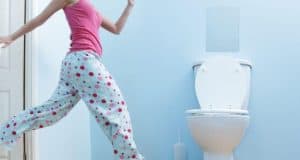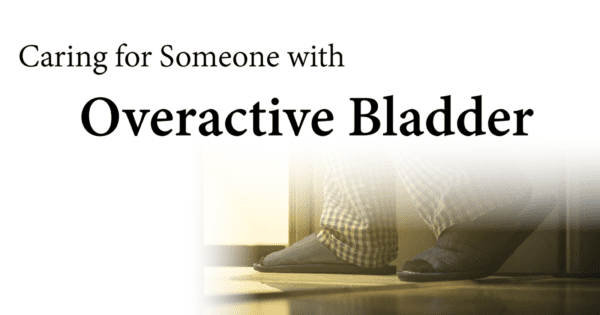Many people wait to talk about their urinary symptoms for years due to embarrassment or may think there isn’t treatment available to manage it. Hesitating to speak up about the symptoms one is experiencing from an overactive bladder (OAB) can significantly impact that person’s quality of life and make treatment more difficult the longer they wait. It is important to know that this bladder condition can occur at any age in both men and women, but as we age, the risk increases. Therefore, addressing the symptoms with your doctor as soon as they start is essential.
Overactive Bladder Symptoms
There is a combination of symptoms that are directly related to an overactive bladder. These symptoms can significantly impact a person’s quality of life, so they should be taken seriously. If you are caring for someone that begins to show signs of any of these symptoms, consider starting a conversation with them and discuss seeking medical advice.
Urge Incontinence
A strong, sudden, and unintentional urge to urinate is called urge incontinence. The bladder muscles involuntarily contract and cause an immediate urge to urinate, sometimes resulting in leakage of urine. Urge incontinence can be caused by constipation, stroke, multiple sclerosis, or any other health condition that can affect a person’s bladder to properly hold urine.
Nocturia
Having the need to get up frequently throughout the night is referred to as nocturia. This can be a very tiring and frustrating symptom of an overactive bladder. A person with nocturia will likely lack a good night’s rest, affecting their alertness and activity levels throughout the day. Addressing nocturia as a symptom of OAB is important before it starts to affect a person’s productivity and relationships.
Frequent Urination
 Frequent urination occurs when someone finds themselves using the restroom many more times than normal within a 24-hour period of time. Underlying health conditions such as diabetes, prostate issues, or urinary tract infections can cause frequent urination and should not be ignored. Treatment of those conditions can possibly eliminate this symptom altogether. Avoiding addressing this symptom of OAB can disturb one’s daily routine as well as lead to nocturia, disrupting sleep.
Frequent urination occurs when someone finds themselves using the restroom many more times than normal within a 24-hour period of time. Underlying health conditions such as diabetes, prostate issues, or urinary tract infections can cause frequent urination and should not be ignored. Treatment of those conditions can possibly eliminate this symptom altogether. Avoiding addressing this symptom of OAB can disturb one’s daily routine as well as lead to nocturia, disrupting sleep.
What Causes Overactive Bladder?
Although some specific causes are still unknown, here are some examples of health conditions that can cause overactive bladder:
- Bladder stones and tumors can cause abnormalities in the bladder and lead to OAB. These bladder stones and tumors can block the flow of urine, causing pain and/or frequent urination.
- Diabetes causes damage to the blood vessels and nerves resulting in the inability to control the bladder muscles. Because of the excess glucose in the blood, the kidney reacts and produces more urine, causing frequent urination.
- Urinary tract infections, if left untreated, can lead to OAB. More common in women than men because of the shorter length of their urethra, urinary tract infections happen when bacteria enters the bladder. This causes an uncontrollable urge to urinate and typically only small amounts at a time.
- Neurological disorders such as multiple sclerosis, Parkinson’s disease, or a stroke can cause OAB. Since these conditions cause damage to the body’s nervous system, those with these disorders suffer from bladder muscles contracting before the bladder is full, leading to urge incontinence and/or frequent urination.
- Certain medications that are taken can also be a contributing factor to OAB or the worsening of it. Some medications can cause frequent urination. If you are caring for someone with these or other health conditions, take note of their symptoms and speak to their doctor if you sense the medication is the cause or simply making it worse.
Ways to Help Manage Overactive Bladder
If you are caring for someone with OAB, there are some things that you can do to help your patient or loved one manage their bladder condition.
Keep a Bladder Journal
One of the first things you can do is start recording the frequency and amount of urination your patient or loved one empties from their bladder throughout the day and night. Keeping a Bladder Journal is easy and can be taken to doctor appointments to better understand the severity of the condition.
Maintain a Healthy Weight and Diet
 Because excess weight can put pressure on the bladder, those extra pounds can lead to urge incontinence. Developing an exercise plan you can do with them, such as taking brisk walks in the neighborhood, doing a television workout, or practicing yoga, can be beneficial to both of you.
Because excess weight can put pressure on the bladder, those extra pounds can lead to urge incontinence. Developing an exercise plan you can do with them, such as taking brisk walks in the neighborhood, doing a television workout, or practicing yoga, can be beneficial to both of you.
When caring for someone with an OAB, try to incorporate healthy foods that are rich in fiber to help with overall digestion. Since the bowels sit very close to the bladder, if one becomes constipated, additional pressure on the bladder is felt, resulting in frequent urination. Try to avoid diuretics such as caffeine and alcohol that can contribute to the bladder muscles involuntarily contracting, leading to urge incontinence.
Try to Avoid Directive Statements
When speaking to your patient or loved one you are caring for, try to avoid statements that include words such as “should” or “don’t,” as these words tend to be discouraging. Rather than saying, “Don’t try to hold your urine in.” or “You shouldn’t feel embarrassed about your condition.”, a more understanding approach can help the patient feel less uncomfortable about the symptoms they are already experiencing.
What are the Treatment Options for OAB?
A great first step is to start keeping a Bladder Journal. This will help monitor the frequency and amount of voids and can be taken to the doctor to better understand the severity of your patient or loved one’s condition. After this behavioral treatment, there are other options available that have proved to be successful.
Pelvic Floor Exercises

Both men and women can benefit by strengthening the pelvic floor muscles that help control the involuntary contractions of the bladder. Also referred to as Kegel exercises, a doctor or physical therapist can correctly discuss how these are to be practiced. When the Kegel exercises are regularly performed, the bladder is better supported, preventing accidental urine leakage. These pelvic floor exercises also help train the bladder to hold urine for longer periods of time until the bladder is full, reducing or eliminating urge incontinence.
Absorbent Pads, Briefs, and Protective Underwear
Choosing the right incontinence pad , briefs, or protective underwear safeguards one’s clothing and can help avoid embarrassing accidents. Offered in a wide range of sizes, shapes, and absorbencies, these incontinence pads, briefs, and protective underwear allow the user to enjoy their daily activities and have uninterrupted nights. These incontinence products can help the patient or loved one lead a more dignified life that doesn’t involve limiting their activities.
, briefs, or protective underwear safeguards one’s clothing and can help avoid embarrassing accidents. Offered in a wide range of sizes, shapes, and absorbencies, these incontinence pads, briefs, and protective underwear allow the user to enjoy their daily activities and have uninterrupted nights. These incontinence products can help the patient or loved one lead a more dignified life that doesn’t involve limiting their activities.
Medications
Some medications can help relieve symptoms by relaxing the bladder, reducing urge incontinence occurrences. Many medications come with side effects such as dry mouth, dry eye, or constipation. Most of the time, the doctor will suggest ways to keep the side effects to a minimum or completely under control.
Surgery
Although there are many options that don’t require surgery, this may be the only option for those with severe OAB. One type of surgery involves using a portion of the bowel to increase the bladder’s capacity. An intermittent catheter will likely need to be used to empty the bladder after this type of surgery.
A last resort is the removal of the bladder itself. Once the bladder is removed, a stoma is constructed on the abdomen, and a urostomy pouch is attached to collect urine into a collection device.
When caring for someone with OAB, remember the importance of being patient, listening, observing, and reporting. Keep a track record, share information with their doctor, and most of all, have compassion and an encouraging attitude. An overactive bladder can be embarrassing and discouraging, so the more you can motivate and support your patient or loved one, the better their quality of life.
For more information about caring for someone with an OAB or any of the home delivery medical supplies we carry, contact us, and one of our Personally Delivered Product Experts will be happy to help.

